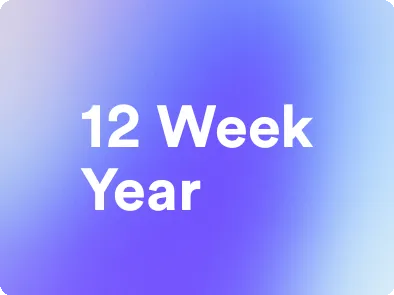The 12-Week Year: A Productivity Strategy
This guide will walk you through the essential elements of using 12 week year - the productivity method to keep your team productive and engaged.
Try Lark for Free
In today's fast-paced world, where time seems to slip through our fingers, traditional annual goal-setting methods often fall short in delivering the desired results. The 12-Week Year presents a revolutionary approach, condensing a year's worth of achievements into focused, high-impact 12-week increments. This article will delve into the concept of the 12-Week Year, its origins, who can benefit from it, the pros and cons, how to get started, actionable tips, do's and dont's, practical examples, step-by-step guidelines, and frequently asked questions to provide a comprehensive understanding of this productivity strategy.
Introduction to the 12-Week Year
The 12-Week Year is a goal-setting and execution system that enables individuals and organizations to achieve their long-term objectives through short-term, focused execution. It allows for heightened results by narrowing the execution timeframe from the conventional 12 months to just 12 weeks. This approach creates a sense of urgency, thereby fostering greater accountability and improved performance.
The Origin and Evolution of the 12-Week Year
The concept of the 12-Week Year was introduced by Brian P. Moran and Michael Lennington in their book "The 12 Week Year: Get More Done in 12 Weeks than Others Do in 12 Months." The system is rooted in the principles of strategic execution and was developed to assist individuals and organizations in overcoming the common pitfalls of traditional annual planning. Since its introduction, the 12-Week Year has garnered attention across various industries and continues to evolve as a leading productivity strategy.
Use Lark to unleash your team productivity.
Who Can Benefit from the 12-Week Year?
The 12-Week Year is a versatile methodology suitable for a wide range of individuals and groups. Its adaptability allows it to be effectively utilized by individual professionals, small business owners, and corporate teams. This strategy proves beneficial for anyone seeking to enhance their productivity, efficiency, and goal achievement within a shorter timeframe.
Pros and Cons of Implementing the 12-Week Year
Advantages of 12-Week Year
- Provides a sense of urgency and heightened focus
- Promotes agility and flexibility in goal setting
- Fosters a high level of accountability and motivation
- Allows for frequent assessment and adjustment of goals
Limitations and Challenges
- Potential for increased stress due to the condensed timeline
- Risk of burnout if not managed effectively
- Requires strong discipline and commitment to maintain momentum
- Possibility of overlooking long-term, strategic planning
Learn more about Lark x Productivity
Getting Started with the 12-Week Year
Understanding the Basics
To embark on the 12-Week Year journey, it is crucial to grasp the fundamental principles that underpin this strategy. It requires a shift in mindset, emphasizing the importance of short-term, focused execution in achieving significant results.
Setting Clear and Achievable Goals
Central to the 12-Week Year is the establishment of clear, achievable goals that align with long-term objectives. These goals should be specific, measurable, and time-bound, providing a roadmap for focused action within the 12-week timeframe.
Tracking Progress
Implementing the 12-Week Year involves diligent tracking of progress. This may include daily, weekly, and monthly assessments to ensure that activities are aligned with the defined objectives.
Use Lark to unleash your team productivity.
Examples of Successful Implementation
Personal Productivity
Personal Productivity
Sarah, a marketing executive, adopted the 12-Week Year to enhance her productivity. By setting precise goals and leveraging focused execution, she significantly increased her project output and achieved her quarterly targets with greater consistency.
Team-based Projects
Team-based Projects
A software development team implemented the 12-Week Year for their project timelines. Through synchronized efforts and enhanced accountability, they successfully delivered a complex software module ahead of schedule, showcasing the effectiveness of this approach in a team setting.
Business Growth
Business Growth
A small business owner applied the 12-Week Year to optimize sales and marketing initiatives. This resulted in a substantial increase in revenue within the 12-week period, highlighting the potential for rapid business growth through strategic execution.
Actionable Tips for Successful Implementation
Time Management Techniques
- Utilize time blocking to allocate specific time slots for priority tasks.
- Implement the Pomodoro Technique to maintain focus and productivity throughout the day.
Accountability Strategies
- Establish an accountability partnership to ensure mutual support and encouragement.
- Use progress-tracking tools and systems to maintain a clear view of your advancements.
Leveraging Technology
- Explore project management software to streamline your task management and progress tracking.
- Leverage digital tools for time tracking, enhancing efficiency in your daily activities.
Do's and Dont's of the 12-Week Year
| Do's | Dont's |
|---|---|
| Clear goal setting | Overloading goals |
| Consistent review and adjustment | Neglecting evaluation and adjustment |
| Effective time blocking | Ignoring work-life balance |
Use Lark to unleash your team productivity.
Conclusion
In conclusion, the 12-Week Year offers a transformative approach to goal setting and execution, propelling individuals and organizations towards heightened productivity and performance. By condensing yearly objectives into focused 12-week periods, this strategy instills urgency, accountability, and agility, leading to accelerated goal achievement and sustained success.
